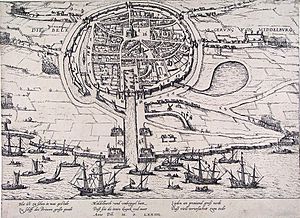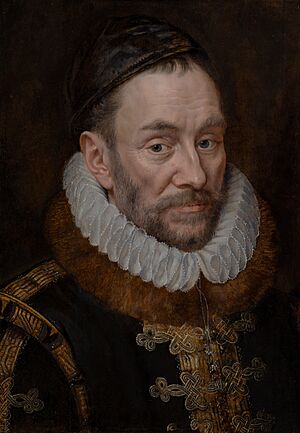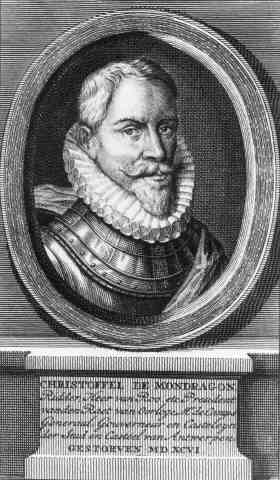Siege of Middelburg (1572–1574) facts for kids
Quick facts for kids Siege of Middelburg (1572–1574) |
|||||||
|---|---|---|---|---|---|---|---|
| Part of the Eighty Years' War | |||||||
 Map of the Siege of Middelburg by Frans Hogenberg |
|||||||
|
|||||||
| Belligerents | |||||||
| Commanders and leaders | |||||||
| Strength | |||||||
| 5,000 | 3,000 | ||||||
| Casualties and losses | |||||||
| Unknown Many to disease |
Heavy Surrender of garrison |
||||||
The Siege of Middelburg was a long battle that took place from 1572 to 1574. It was part of the Eighty Years' War, a fight for independence in the Netherlands. During this siege, Dutch rebels, supported by English soldiers, surrounded the city of Middelburg. Spanish forces, led by Cristóbal de Mondragón, defended the city. The siege began on November 4, 1572. The Spanish held out for a very long time. They finally gave up on February 18, 1574. This happened after their attempt to get help for Middelburg was stopped at the Battle of Reimerswaal.
Contents
Why Did the Siege Happen?

The Netherlands was once ruled by Philip II of Spain. His policies made many people in the Netherlands unhappy. By 1568, William I of Orange, a powerful Dutch leader, and other nobles were tired of Spanish rule. They started a series of revolts. These revolts were mainly about religion and money. People also wanted to end the harsh rule of the Spanish governor, the Duke of Alba.
The Dutch rebels wanted to force Alba and his Spanish troops out. This led to more fighting and the start of the Eighty Years' War. In April 1572, a group of Dutch rebels called the Sea Beggars captured the town of Brielle. This was a big deal and caused many other towns to join the rebels. Soon, most of the province of Zeeland was under rebel control. Only Arnemuiden, Middelburg, and Goes remained under Spanish rule. William of Orange, with help from English troops sent by Queen Elizabeth I, planned to capture these cities.
Before the main siege, rebels caused a lot of damage. They looted buildings and burned churches. Many villages and towns like Arnemuiden and Veere joined the rebel side. Middelburg, however, had a strong Spanish army. In April 1572, about 1,100 Dutch rebels tried to attack Middelburg. They failed due to lack of supplies. Later, a smaller group of 100 rebels managed to get past the outer defenses. But the Spanish soldiers quickly pushed them back.
On November 4, 1572, a larger force arrived. Nearly 1,500 Dutch and English soldiers, led by Jerome Tseraerts, came to Walcheren island. They then made plans to officially besiege Middelburg.
The Siege Begins
The rebels quickly blocked the waterways around Middelburg. This stopped supplies from reaching the city. The rebel army included English soldiers led by Thomas Morgan. It also had some Scottish soldiers and new recruits from England.
Jerome Tseraerts was promised to become the leader of Walcheren island if he captured Middelburg. The rebels attacked Westhoven Castle, east of the city, and took it. They then looted and burned a nearby abbey. The Spanish governor of Walcheren, Antoine of Burgundy, kept telling the Duke of Alba how hard things were in Middelburg. Alba ordered Cristóbal de Mondragón to go to Middelburg. Mondragón was to destroy the rebel positions and get supplies into the city. He also took over as the city's leader, and Antoine of Burgundy became mayor.
In early December, Spanish commander Sancho d'Avila arrived. He was ordered to send help by sea. He gathered a fleet of ships. His goal was to capture Flushing from the rebels and control the waterways. D'Avila also sent some soldiers by land to Middelburg, successfully bringing in supplies. But his fleet was stopped and defeated by the Sea Beggars at the Battle of Flushing. He lost five ships.

1573: A Hard Winter
At the start of 1573, the Dutch captured Popkensburg Castle, just north of Middelburg. Inside the city, food became very scarce, especially during the cold winter. Both citizens and soldiers suffered from hunger. People who were sick or very poor were forced out of the city to save food. In July, after the Spanish failed to relieve Haarlem, William of Orange took over command of the siege from Tseraerts.
On August 5, the Dutch and English captured Fort Rammekens. This meant the rebels were slowly taking over all the strong points around Middelburg. By Christmas, the food shortage was so bad that between 1,000 and 1,500 people died from hunger and disease.
1574: The Final Push
By January 1574, the situation in Middelburg was desperate. The Duke of Alba was replaced by a new Spanish governor, Don Luis de Requesens. Requesens ordered a rescue mission for Middelburg. He gathered a fleet of seventy ships. Another hundred ships were to join them. However, this rescue attempt was a disaster. The Sea Beggars attacked the Spanish ships before they could even reach Middelburg. Not one Spanish ship made it through. This was a huge defeat for Spain.
In early February, Middelburg had no food for at least twelve days. Mondragón sent messages to Requesens, but they never got through. On February 4, William of Orange sent a personal message to Mondragón. He told him to surrender the city within four days. More Dutch, English, and Scottish troops arrived, completely surrounding Middelburg.
The City Surrenders
Mondragón, a tough commander, first refused to give up. He even set fire to some houses to show he would fight to the end. But William of Orange offered a deal. He suggested a meeting where Mondragón could surrender with honor. His soldiers could leave with their weapons and flags. Mondragón was worried about the people in the city. He knew about the terrible massacres the Spanish had carried out in other cities like Haarlem and Naarden. He asked William to promise that the people and religious leaders would not be harmed. William agreed.
On February 18, both William of Orange and Mondragón signed the agreement. On February 23, the Spanish soldiers, who were hungry and poorly equipped, left Middelburg. The Catholic religious leaders also left the city.
What Happened Next?
With Middelburg's surrender, the entire island of Walcheren was now under Dutch and English control. This island was very important because it controlled the two main entrances to the Scheldt river. The city of Leiden, which the Spanish had been besieging since November 1573, still held out for William of Orange.
After the defeat, Mondragón took his army to Zuid-Beveland. The next year, he captured Duiveland and then Zierikzee. Jacobus Schotte, a Dutch commander, was rewarded by William of Orange. He was made mayor of Middelburg.
George Gascoigne, an English soldier and poet, took part in the siege. William of Orange gave him extra money for his role in the Spanish surrender. Gascoigne even wrote a poem about the surrender:
|
‘And when Mountdragon might no more endure |
Images for kids
See also
 In Spanish: Sitio de Middelburg (1572-1574) para niños
In Spanish: Sitio de Middelburg (1572-1574) para niños




